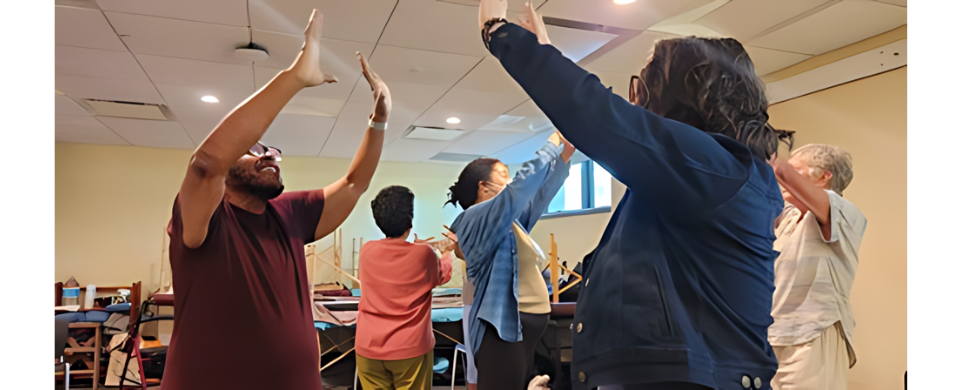by T. Nagai-Rothe
PART 1: Shintaido “Software”
When I began practicing Shintaido in 1988 in San Francisco, there were many teachers and students. Most everyone was young-ish and physically strong. I was in my early 30s. I loved Ocean Beach in the morning and being near the water, but I often struggled to keep up during our practice of Shintaido “hardware.”
In 1994 H.F. Ito began developing Shintaido software: applications of Shintaido for those outside of the martial arts. He designed and taught classes for caregivers whose family members were facing the end of life and needed relaxation and exercise routines to ensure they didn’t burn out.*
The software applications focused on this particular audience. The Caregiver Workshops continued for nine years to great demand and appreciation, and became part of H.F. Ito’s worldwide Taimyo peacemaking journey that continues today as the Global Taimyo Community (See the DayStreetDojo site – Writings and Videos sections).
The Caregiver Workshops answered the question that John Seaman often posed, “To what end?” What do we hope to accomplish through our practice? What intention do we hold? I have been intrigued with the possibilities of Shintaido software for many years. It requires me to think beyond my assumptions about the benefits of Shintaido and see it from someone else’s perspective.
When we bemoan the lack of Shintaido students, we may be tempted to cast our minds back to the days of big classes and workshops to see how we can recreate that environment. However, I think it’s more effective to find groups of people and listen to what they need, i.e., where is the demand, and what is the demand?
PART 2: A Courageous Audience
In my Body Dialogue article last Fall, “Where Keiko and Worship Meet” I described the low barrier, seated practice I developed for my friends with medical challenges via Zoom in 2021-2022. This led to a weeklong in-person workshop in 2023 for the Religious Society of Friends (Quakers) entitled, “Gentle Movement for Traumatic Times.” The design was in response to F/friends who had experienced racial trauma, and drew upon Wakame, Bamboo, Soto Irimi as creative responses to conflict.
This summer I offered the same in-person weeklong workshop for Friends entitled, “Moving Gently to Address Stress & Conflict.” Our 23 participants quickly created a community space as we practiced the following principles and techniques.
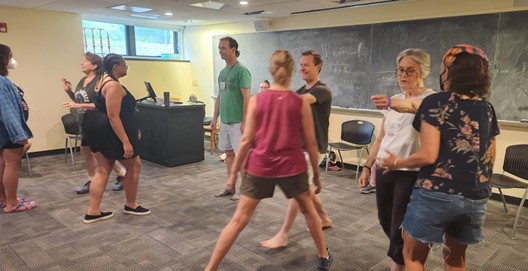
Principles We Practiced
- Managing the field of play – hold the big picture and the physical space
- Clear beginnings and endings (bow in, bow out)
- Working with spacing and timing as a strategic advantage
- How to make our partners brighter and help them move toward their vision
- How conflict can be generative
- The importance of compassion and connection
- Leadership-followership – through kumite
- Instinctive responses vs. creative responses to conflict
- Closing up the space to your opponent
- Staying as physically close to an attacker as possible
- Changing the plane of one’s body
- Pivoting to share the same perspective
- The importance of a sincere attack – without a sincere attack, transformation is impossible
Techniques We Practiced
- Shock-Rock-Seaweed-Bamboo – Shock and rock as instinctive, tense responses to life vs. seaweed and bamboo – going with the flow and standing firm
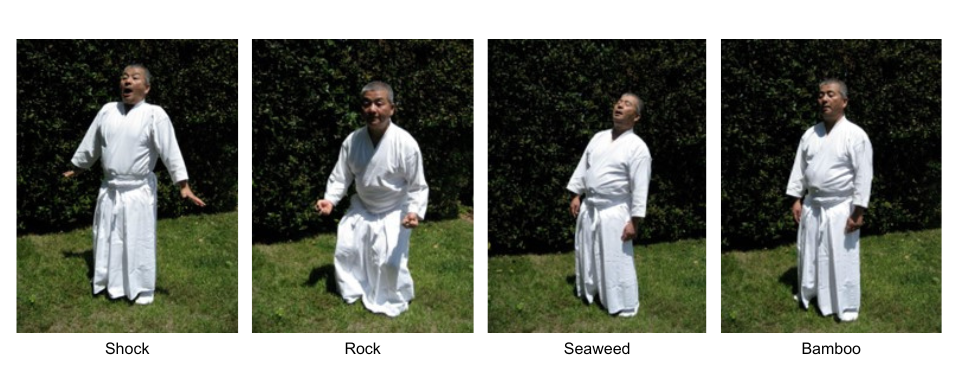
- Stepping In (Soto Irimi) – Stepping toward an opponent and changing the plane of one’s body
- “Welcome, this way please” (Ushiro Irimi) – Stepping toward an opponent to greet them, then pivoting to walk with them and share the same perspective
- Heavenly Truth (Tenshingoso)
- Blue Sky (Aozora Taiso)
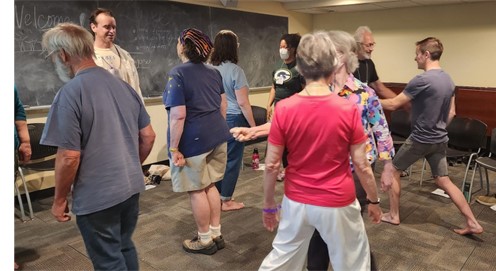
I made a point of using translated, rather than Japanese terms, for ease of understanding: I didn’t expect people to wade through unfamiliar words. The entire workshop centered on accessibility – from options for seated practice, English-language terms and a focus on the practical applications of martial arts techniques in daily life.
Participants spent small group time talking about how each technique shed light on interactions with family members, managers, and colleagues in the past and present. How do we protect ourselves from being hurt in a conflict? How do we deal with challenging colleagues compassionately?
Our “Ah Ha” moments included:
- A sense of agency in conflict, with confidence to move in, yet stay safe
- How standing close-in, “beneath the “sword” is the safest place to be – while stepping back is just the opposite
- Turning in order to stand shoulder to shoulder with the person coming at us and share the same perspective
One person shared a story about her friend changing the field of play. The woman was walking home at night when she felt a hand on her shoulder, and she knew what that meant. In a split second, she decided to engage with the man and not be a victim. As she turned, she said, “Hi! How are you doing? How is your mom?” The man was so startled he ran off. A wonderful example of connection as defense.
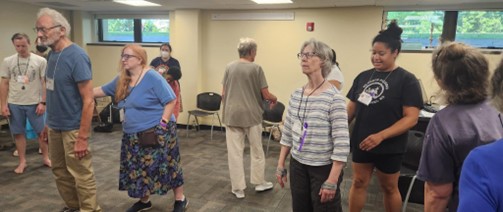
By the end of the week the group was brighter. The feedback I received showed that the effect of the workshop was much deeper than last year.
- “Your teachings and the approach/energy/philosophy have had a seismic influence on my daily life, professionally and interpersonally.”
- “It was a life altering experience.”
Because the curriculum was the same both years, I have been asking myself, “What was different this year?” From a technical perspective, I had internalized the workshop design so it was easier to focus on the “to what end?” of practice. Mostly, I think being able to embody what I was teaching and focus on the potential benefits made the difference. Benefits in the foreground: movement in the background.
Everyone brought a clear-eyed sense of how and where to put these tools and approaches to work in daily life. When interpersonal issues emerged, I challenged everyone to address them honestly and compassionately, as part of our practice – and we did. The group was courageous and they focused on much more than just feeling good.
Part 3: Seeking Reconciliation
This audience expressed a need for something beyond stress management and health: a clear demand for key somatic and interpersonal lessons from the martial arts. I saw a deep need for connection and reconciliation in the face of conflict. Participants really spent time applying the tools to conflictual situations at work and at home.
Post-workshop I’ve had strong demand for more – unlike any other workshop or class I’ve led – so I will have an opportunity to fine tune and iterate the offering. I am curious to see what needs emerge from ongoing connection via Zoom and perhaps in-person follow-up sessions.
When I was a Shintaido assistant, Ito reminded me not to teach using my personality – but to rely on the techniques. Even though I think the way I showed up this year made a difference, it felt like I was refracting and focusing energy in a way the group could catch it. Showing up with presence rather than personality.
So, I leave you with these questions:
What is the value proposition that Shintaido offers?
Is it what people really want and need? Is there demand – and if so, where is it?
Footnote
*Sponsored by the Kaiser Family Foundation through the generosity of Henry Kaiser and organized by Connie Borden, then executive director of Hospice by the Bay.

